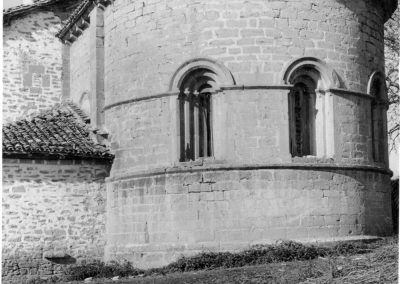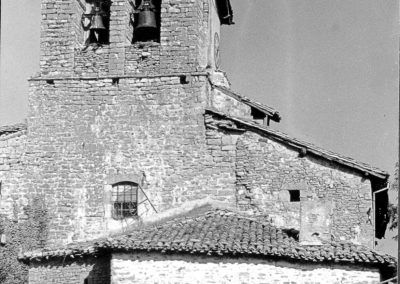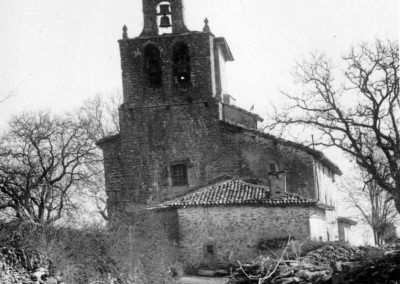
A digital gate open to heritage

INDEX
- Introduccion
- Video
- 360º Images
- The altarpiece of San Blas
- Old photographs
- About the church
- Location
The area of Los Huetos has been an inhabited place since ancient times because of its strategic location near the most frequented traffic routes. For example, an important Visigoth trousseau of the 7th century was found in the cave of Los Goros, being one of the few documented cases from this time in Álava. Although the town is cited in the document Reja de San Millán (1025) as Oto, only a possible wall remains of its original church on its north side, and all that we can see corresponds to the building that was built since the second half of the 12th century. It is surprising to see how, despite the proximity of Hueto Abajo and the historical union that both villages have had, the workshops that built both churches were not related at all.Introduction
Video
360º Images
The baptismal font
Without the slightest doubt, the most outstanding element of this church is the baptismal font. Built in the 13th century, it shows a perfect balance between Romanesque and Gothic elements, which is why it is set at a time of transition between traditional models and the new artistic airs. On the foot, we find a decoration based on grapevine leaves and grapes, and on the upper part of the bowl, a series of trefoil arcades with twenty-two human figures, among which we count prophets, apostles (such as Saint Peter and Saint Paul) and friars. In this group, a beautiful Annunciation with the figures of the angel Gabriel and the Virgin Mary stands out. On the intermediate strips, taking up most of the bowl, there are a series of varied motifs. We can distinguish eagles preying on rabbits, six-petal flowers, birds, monstrous creatures, crosses, designs similar to Gothic stained glass windows, heart-shaped leaves, an Agnus Dei or Lamb of God… Perhaps the most striking scenes are the two that show a fortress with two lions. They might refer to the heraldry of Castile-León, which is not strange in Romanesque churches in Álava.
The exterior The heterogeneity of the Romanesque in Álava allows us to find, in a few kilometres around, a large variety of examples that are, many times, surprising. This is the case of the church of Hueto Arriba, outside of which we can see a simple semicircular east end with three large openings. The imposts, archivolts or discharging arches are completely smooth, without any decoration, and it is impossible to know the reason for this peculiarity today. They could have been decorated with paint or, for unknown reasons, perhaps they were not sculpted, as it is usual in this type of buildings. In any case, the architecture, sober and with perfectly traced lines, faces us with a temple of certain ambition.The church of the Nativity
The facade
The facade is where all the sculpted decoration that we miss on the east end appears. We find an imitation of the Portada Speciosa of Estíbaliz, a model for many Romanesque churches in Álava. Due to its simplicity and finishes, it could have been made by the same workshop that sculpted the facade of Argandoña. It has a slightly pointed double archivolt. The inner one is covered by acanthus-based vegetation and the outer one, by spherical fruits held by leaves. The shafts of the columns are decorated with basket patterns and a pattern of four-petal flowers, following the work of the Estíbaliz workshops and, therefore, the sculptural tradition of the French Burgundy region. The capitals of the columns show acanthus leaves, a kind of vegetal vines and a male face with shoulder-length hair. .
Interior
The vaults of the temple could correspond to a somewhat posterior stage than the construction of the walls of the building. We find a single nave divided in three sections plus the presbytery, which we can access through a beautiful triumphal arch. The capitals of this arch, supported on two half columns, are decorated in a peculiar way. On the left ones, we see slim leaves, but on the right ones there are fish, carried out in a schematic way, and snakes, whose tails coil at the corners forming a volute.
The altarpiece
The east end is covered with an altarpiece from the 18th century, in whose centre appears an Andra Mari from the late 13th century. There must have been a deep devotion to this type of images in this period throughout Álava, since these carvings of the Virgin with the Child are very frequent, although they vary greatly in their quality. In this case, we find a good model with a subsequent repainting.
The side altarpieces
The other two side reredoses are of different styles and periods. The one on the left is dedicated to the Virgin of the Rosary and it dates from the 18th century, of an overelaborated rococo style. The one on the right, carried out in 1740, is neoclassical and houses a painting of Saint Michael with Saint Anthony the Great and Saint Andrew.
Location
Photo credits:
Current photographs: © Alava Medieval / Erdi Aroko Araba
Old photographs: Archive of the Historical Territory of Álava
























